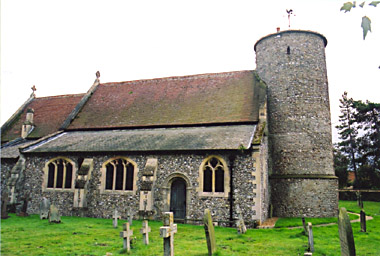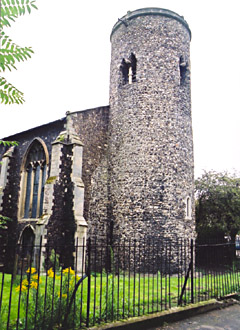
St. Mary, Burnham Deepdale
Photo © S. Alsford
St. Mary's has been the parish church of the Norfolk coastal village of Burnham Deepdale since the eleventh century. The flint round tower was once assumed to evidence a Saxon origin for the church. However, identification of Norman influences on the tower architecture now suggest that it was built after 1066, but using traditional techniques. It is possible that the tower could have been an addition to church.
Round towers were not uncommon in East Anglia, although far fewer in other parts of the country. Although they incorporate Anglo-Saxon architectural features, often these are combined with Norman features. It was likely an Anglo-Saxon form that continued to find favour with builders up into the early twelfth century. Why some towers were round is not known for certain. The argument that it was easier to build a round form than a square-cornered one, when using flint (other types of stone being less common in Norfolk), has now been rebutted. A defensive purpose for the towers is also doubted, since those towers that can be dated with confidence post-date the period of Viking invasions. It has also been suggested that there may be a connection with King Athelstan's ruling (937) that for any man to claim the status of thegn, his land had to have a bell tower on it. However, the reason may simply be cultural influence of Viking settlers, since the earliest round towers were built, in the tenth century, in northern Germany and Scandinavia.

St. Mary Coslany, Norwich
Photo © S. Alsford
The round tower of St. Mary Coslany is also felt to be a product of the intermixing of Anglo-Saxon and Norman techniques. Other evidence supports the possibility that there would have been a church here, with or without a tower, before the Conquest. The tower, even if early Norman, is probably the oldest structure in Norwich. The main body of the present church, however, dates from 1477. In 1974 the church was made redundant and has been used as a crafts and antiques centre; it is in the care of Norwich Historic Churches Trust.